Forecasting Renewable Energy Consumption under Zero Assumptions
Abstract
:1. Introduction
2. Data and Methods
3. Results
3.1. Renewable Energy Supply from Hydroelectric Power Sources, US
3.2. Renewable Energy Supply from Biomass Sources, US
3.3. Total Primary Renewable and Energy Supply, Selected Regions
4. Discussions
5. Conclusions
Acknowledgments
Author Contributions
Conflicts of Interest
Appendix A. Steps to Developing and Utilizing the Zero Assumption LSTM RNN Forecasting Technique
References
- Rogelj, J.; Schaeffer, M.; Friedlingstein, P.; Gillett, N.P.; van Vuuren, D.P.; Riahi, K.; Allen, M.; Knutti, R. Differences between carbon budget estimates unravelled. Nat. Clim. Chang. 2016, 6, 245–252. [Google Scholar] [CrossRef] [Green Version]
- Sachs, J.D.; Schmidt-traub, G.; Williams, J. Pathways to zero emissions. Nat. Geosci. 2016, 9, 799. [Google Scholar] [CrossRef]
- Meinshausen, M.; Jeffery, L.; Guetschow, J.; Robiou du Pont, Y.; Rogelj, J.; Schaeffer, M.; Höhne, N.; den Elzen, M.; Oberthür, S.; Meinshausen, N. National post-2020 greenhouse gas targets and diversity-aware leadership. Nat. Clim. Chang. 2015, 1306, 1–10. [Google Scholar] [CrossRef]
- Watson, R.T.; Rodhe, H.; Oeschger, H.; Siegenthaler, U. Greenhouse gases and aerosols. Clim. Chang. IPCC Sci. Assess. 1990, 1, 17. [Google Scholar]
- Solomon, S.; Daniel, J.S.; Sanford, T.J.; Murphy, D.M.; Plattner, G.-K.; Knutti, R.; Friedlingstein, P. Persistence of climate changes due to a range of greenhouse gases. Proc. Natl. Acad. Sci. USA 2010, 107, 18354–18359. [Google Scholar] [CrossRef] [PubMed]
- Montzka, S.A.; Dlugokencky, E.J.; Butler, J.H. Non-CO2 greenhouse gases and climate change. Nature 2011, 476, 43–50. [Google Scholar] [CrossRef] [PubMed]
- Tian, H.; Lu, C.; Ciais, P.; Michalak, A.M.; Canadell, J.G.; Saikawa, E.; Huntzinger, D.N.; Gurney, K.R.; Sitch, S.; Zhang, B.; et al. The terrestrial biosphere as a net source of greenhouse gases to the atmosphere. Nature 2016, 531, 225–228. [Google Scholar] [CrossRef] [PubMed] [Green Version]
- Yang, J.; Liu, Q.; Li, X.; Cui, X. Overview of wind power in China: Status and future. Sustainability 2017, 9, 1454. [Google Scholar] [CrossRef]
- Beck, F.; Martinot, E. Renewable energy policies and barriers. Encycl. Energy 2004, 34, 365–383. [Google Scholar]
- Lund, H. Renewable energy strategies for sustainable development. Energy 2007, 32, 912–919. [Google Scholar] [CrossRef]
- Verbruggen, A.; Fischedick, M.; Moomaw, W.; Weir, T.; Nadaï, A.; Nilsson, L.J.; Nyboer, J.; Sathaye, J. Renewable energy costs, potentials, barriers: Conceptual issues. Energy Policy 2010, 38, 850–861. [Google Scholar] [CrossRef]
- Panwar, N.L.; Kaushik, S.C.; Kothari, S. Role of renewable energy sources in environmental protection: A review. Renew. Sustain. Energy Rev. 2011, 15, 1513–1524. [Google Scholar] [CrossRef]
- Kandpal, T.C.; Broman, L. Renewable energy education: A global status review. Renew. Sustain. Energy Rev. 2014, 34, 300–324. [Google Scholar] [CrossRef]
- Franzitta, V.; Curto, D.; Rao, D. Energetic sustainability using renewable energies in the mediterranean sea. Sustainability 2016, 8, 1164. [Google Scholar] [CrossRef]
- Li, S.; Li, R. Comparison of forecasting energy consumption in Shandong, China Using the ARIMA model, GM model and ARIMA-GM model. Sustainability 2017, 9, 1181. [Google Scholar] [CrossRef]
- O’Neill, B.C.; Desai, M. Accuracy of past projections of US energy consumption. Energy Policy 2005, 33, 979–993. [Google Scholar] [CrossRef]
- Gilbert, A.Q.; Sovacool, B.K. Looking the wrong way: Bias, renewable electricity and energy modelling in the United States. Energy 2016, 94, 533–541. [Google Scholar] [CrossRef]
- Strachan, N.; Fais, B.; Daly, H. Reinventing the energy modelling–policy interface. Nat. Energy 2016, 1, 16012. [Google Scholar] [CrossRef]
- The National Energy Modeling System: An Overview 2009; DOE/EIA-0581; U.S. Energy Information Administration, Office of Integrated Analysis and Forecasting, US Department of Energy: Washington, DC, USA, 2009; Volume DOE/EIA-05.
- Annual Energy Outlook 2002 with Projections to 2020; U.S. Energy Information Administration: Washington, DC, USA, 2002; Volume DOE/EIA-03.
- Inman, R.H.; Pedro, H.T.C.; Coimbra, C.F.M. Solar forecasting methods for renewable energy integration. Prog. Energy Combust. Sci. 2013, 39, 535–576. [Google Scholar] [CrossRef]
- Foley, A.M.; Leahy, P.G.; Marvuglia, A.; McKeogh, E.J. Current methods and advances in forecasting of wind power generation. Renew. Energy 2012, 37, 1–8. [Google Scholar] [CrossRef] [Green Version]
- Tang, L.; Yu, L.; He, K. A novel data-characteristic-driven modeling methodology for nuclear energy consumption forecasting. Appl. Energy 2014, 128, 1–14. [Google Scholar] [CrossRef]
- Gers, F.A.; Schraudolph, N.N.; Schmidhuber, J. Learning precise timing with LSTM recurrent networks. J. Mach. Learn. Res. 2002, 3, 115–143. [Google Scholar] [CrossRef]
- Wöllmer, M.; Kaiser, M.; Eyben, F.; Schuller, B.; Rigoll, G. LSTM-modeling of continuous emotions in an audiovisual affect recognition framework. Image Vis. Comput. 2013, 31, 153–163. [Google Scholar] [CrossRef]
- Milone, D.; Pitruzzella, S.; Franzitta, V.; Viola, A.; Trapanese, M. Energy savings through integration of the illumination natural and artificial, using a system of automatic dimming: Case study. Appl. Mech. Mater. 2013, 372, 253–258. [Google Scholar] [CrossRef]
- U.S. Energy Information Administration. Monthly Energy Review. Available online: https://www.eia.gov/totalenergy/data/monthly/ (accessed on 4 October 2017).
- International Energy Agency. Unit Converter. Available online: https://www.iea.org/statistics/resources/unitconverter/ (accessed on 1 March 2017).
- Assumptions to the Annual Energy Outlook 2015; U.S. Department of Energy, U.S. Energy Information Administration: Washington, DC, USA, 2015.
- Hamzaçebi, C. Forecasting of Turkey’s net electricity energy consumption on sectoral bases. Energy Policy 2007, 35, 2009–2016. [Google Scholar] [CrossRef]
- Annual Energy Outlook 2008 With Projections to 2030; DOE/EIA-0383; U.S. Energy Information Administration: Washington, DC, USA, 2008; Volume DOE/EIA-03.
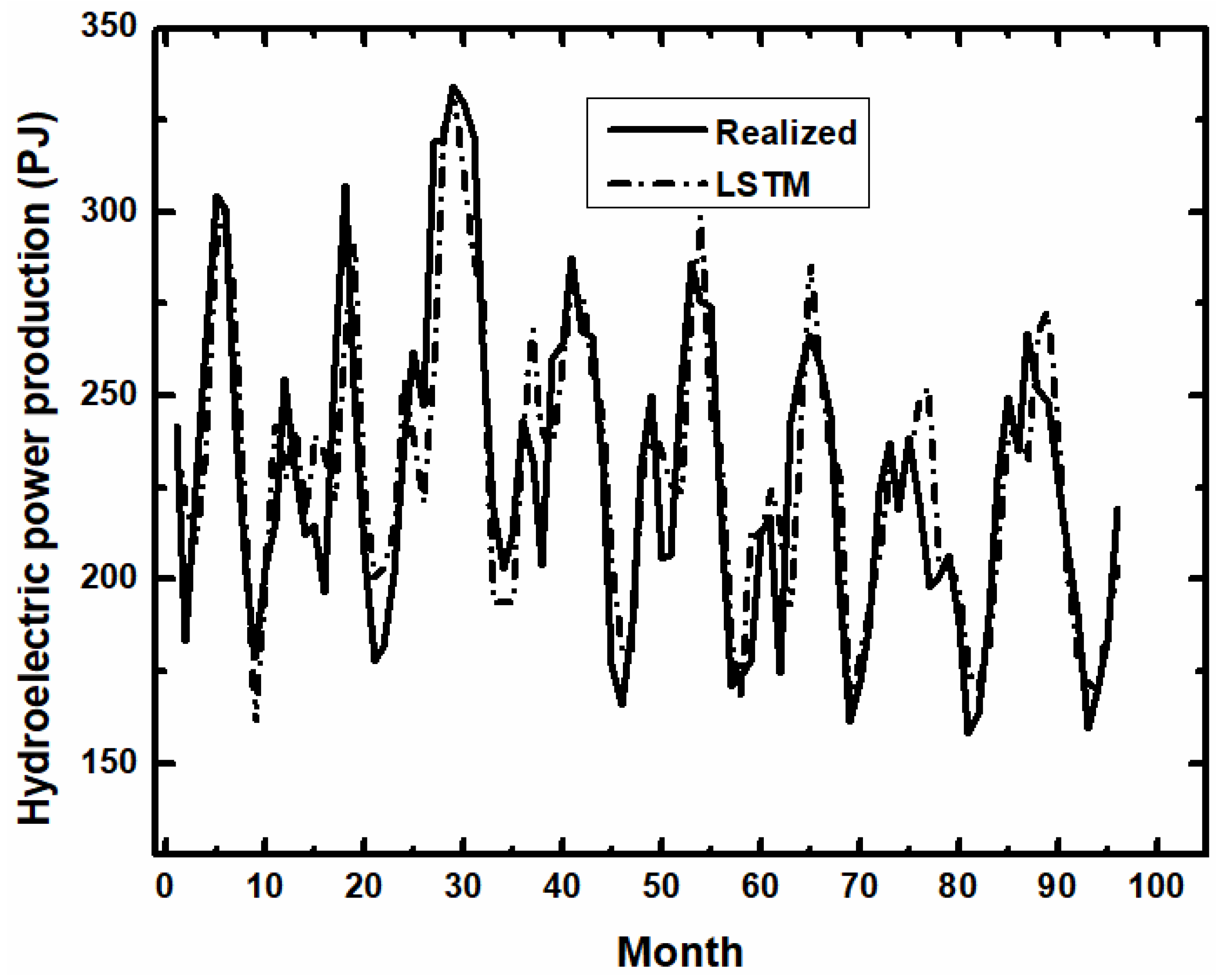
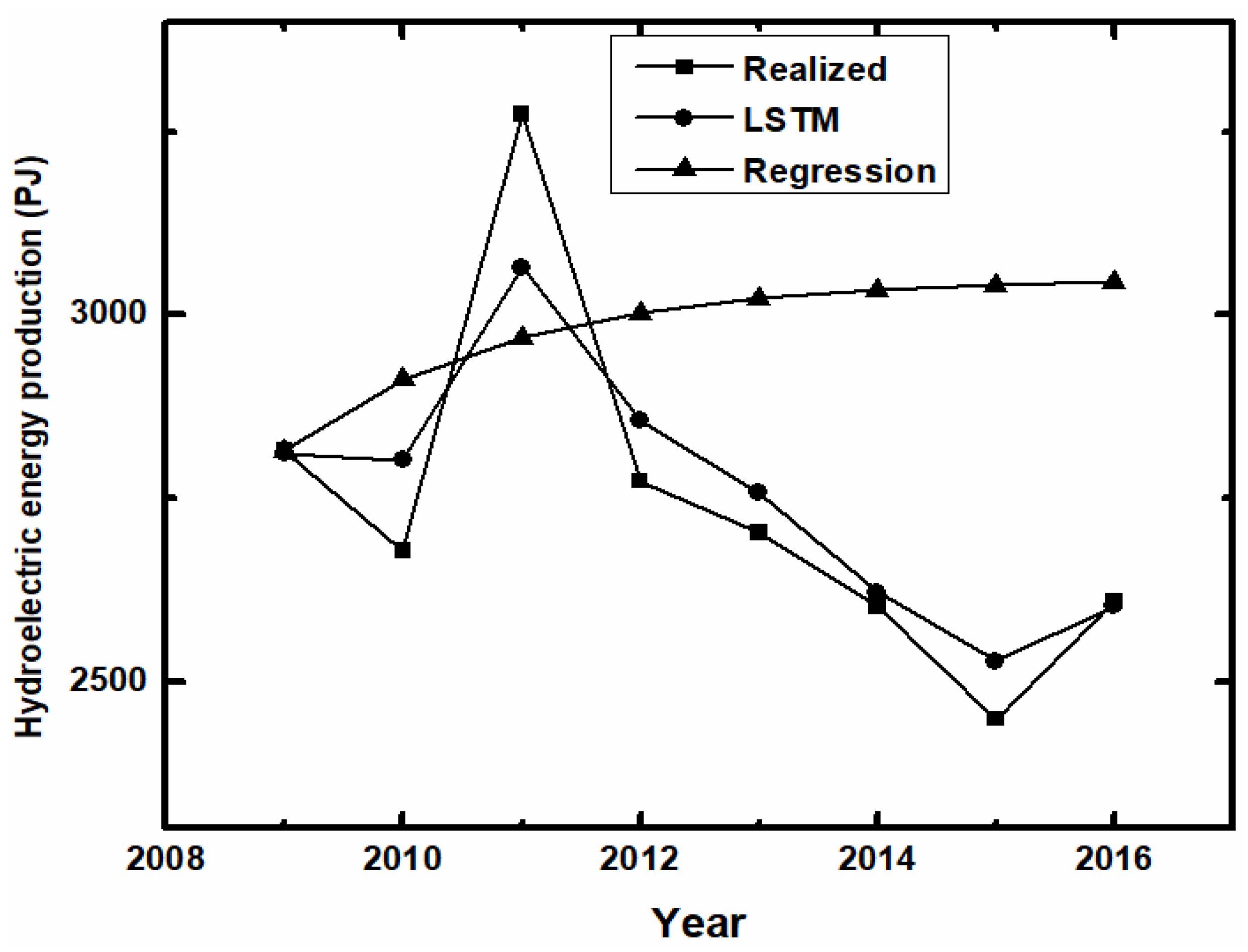
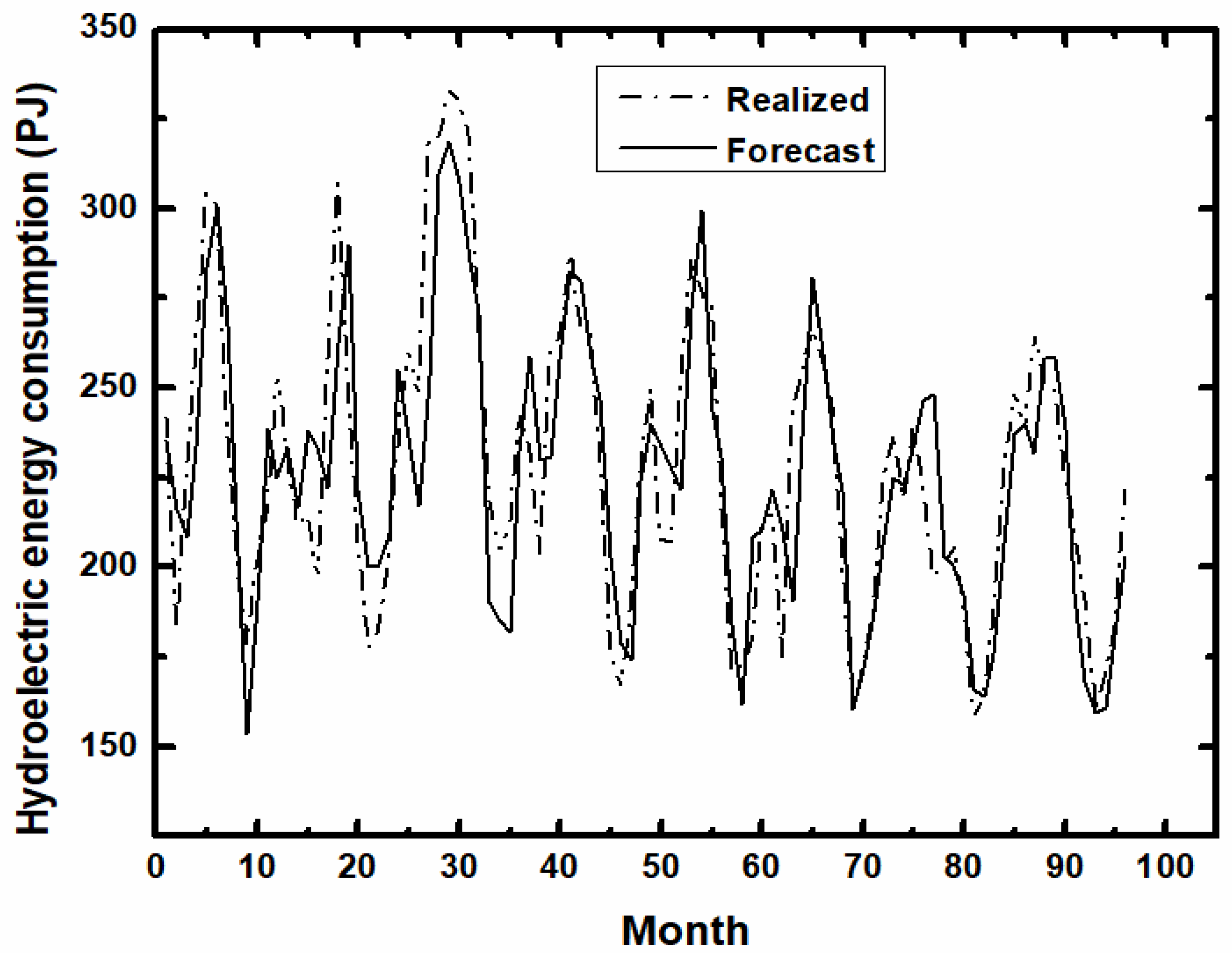

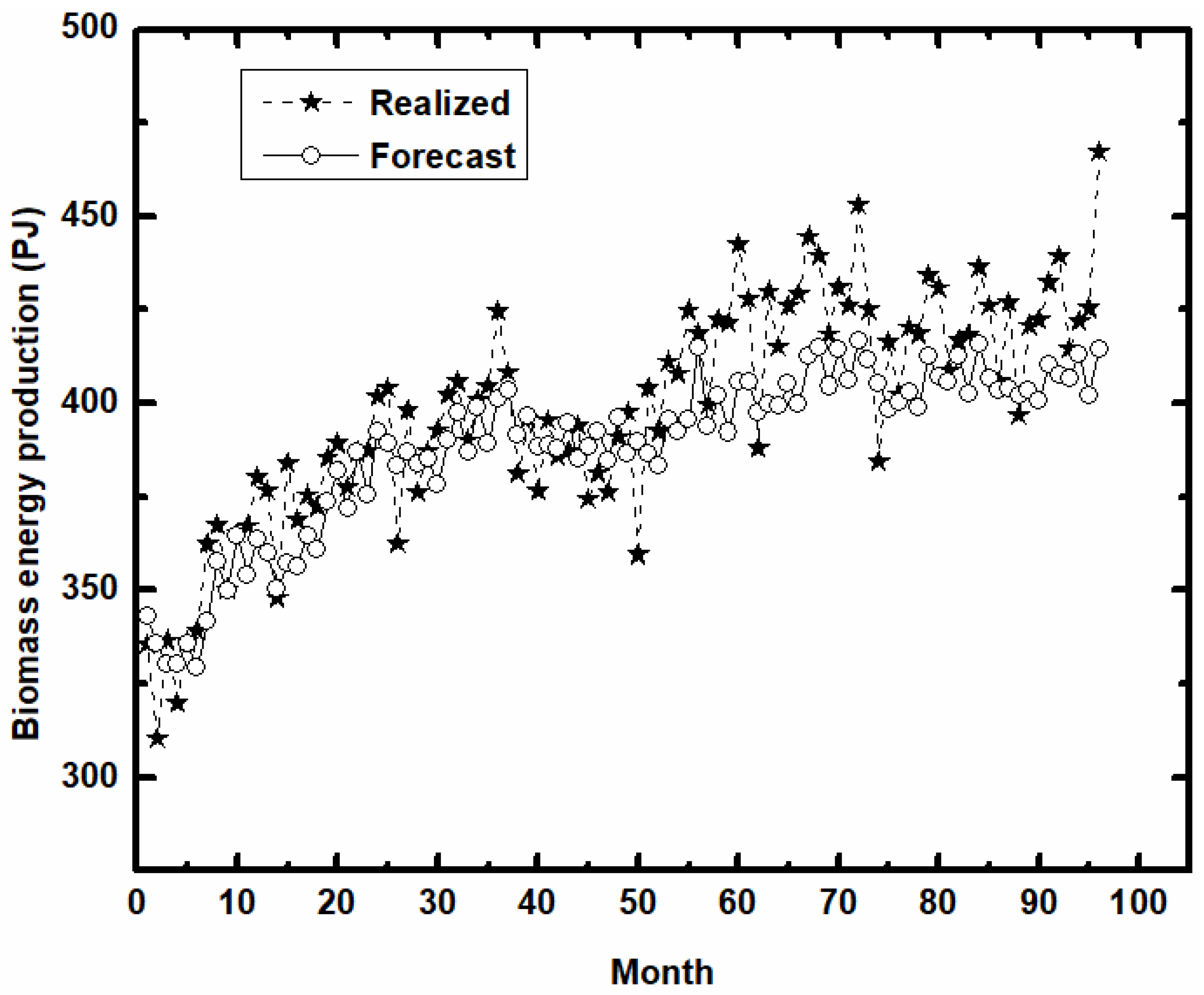
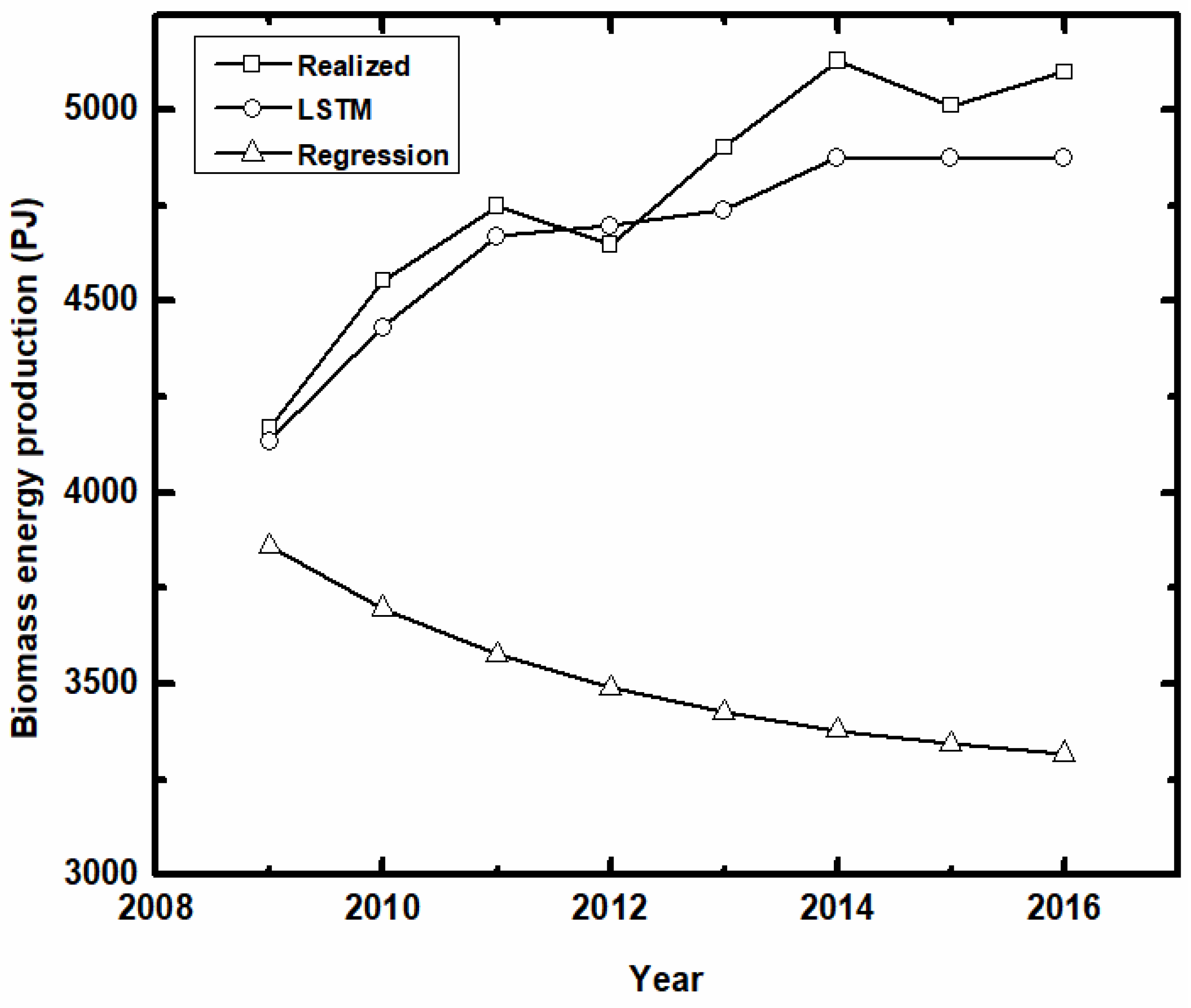
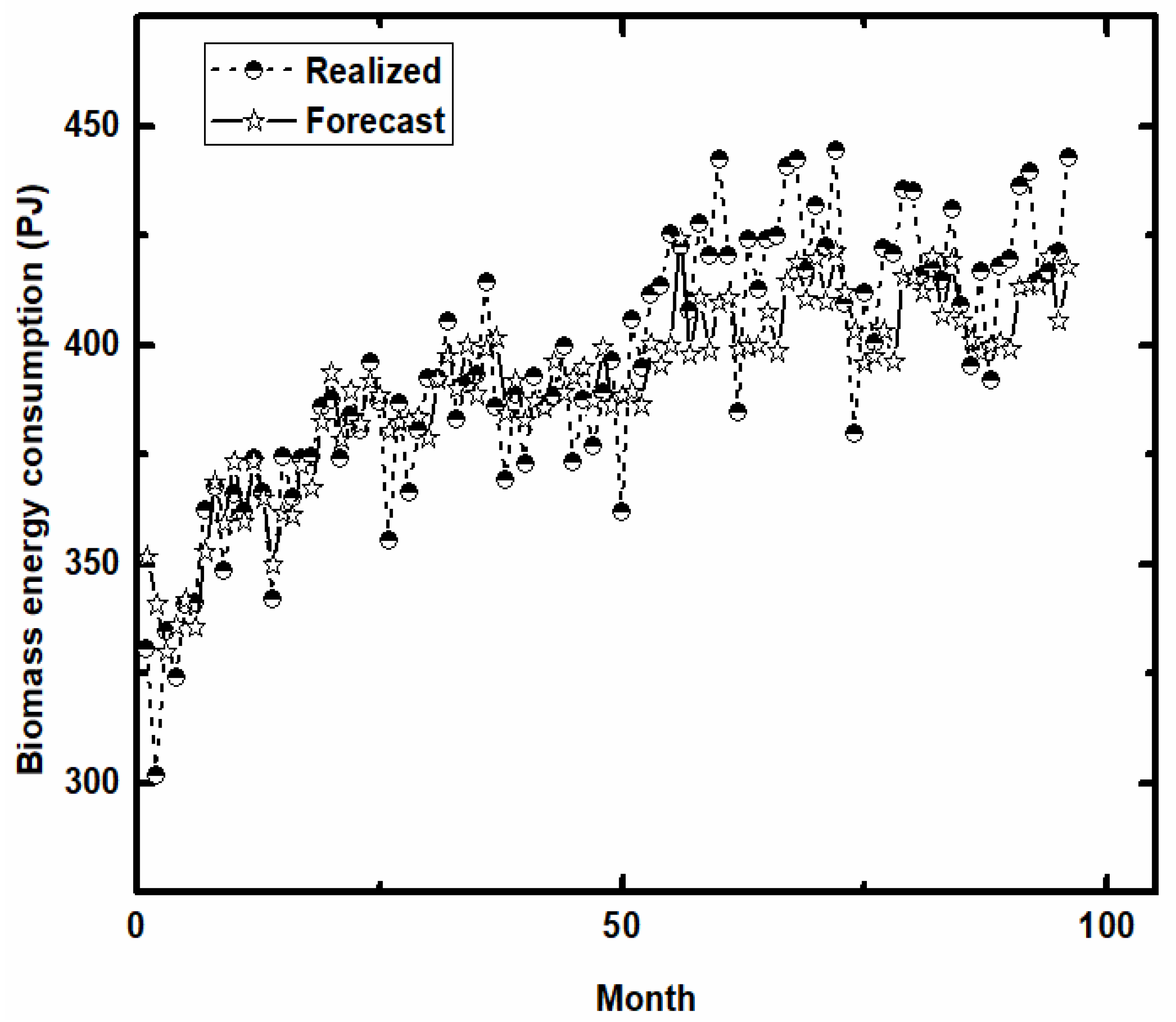
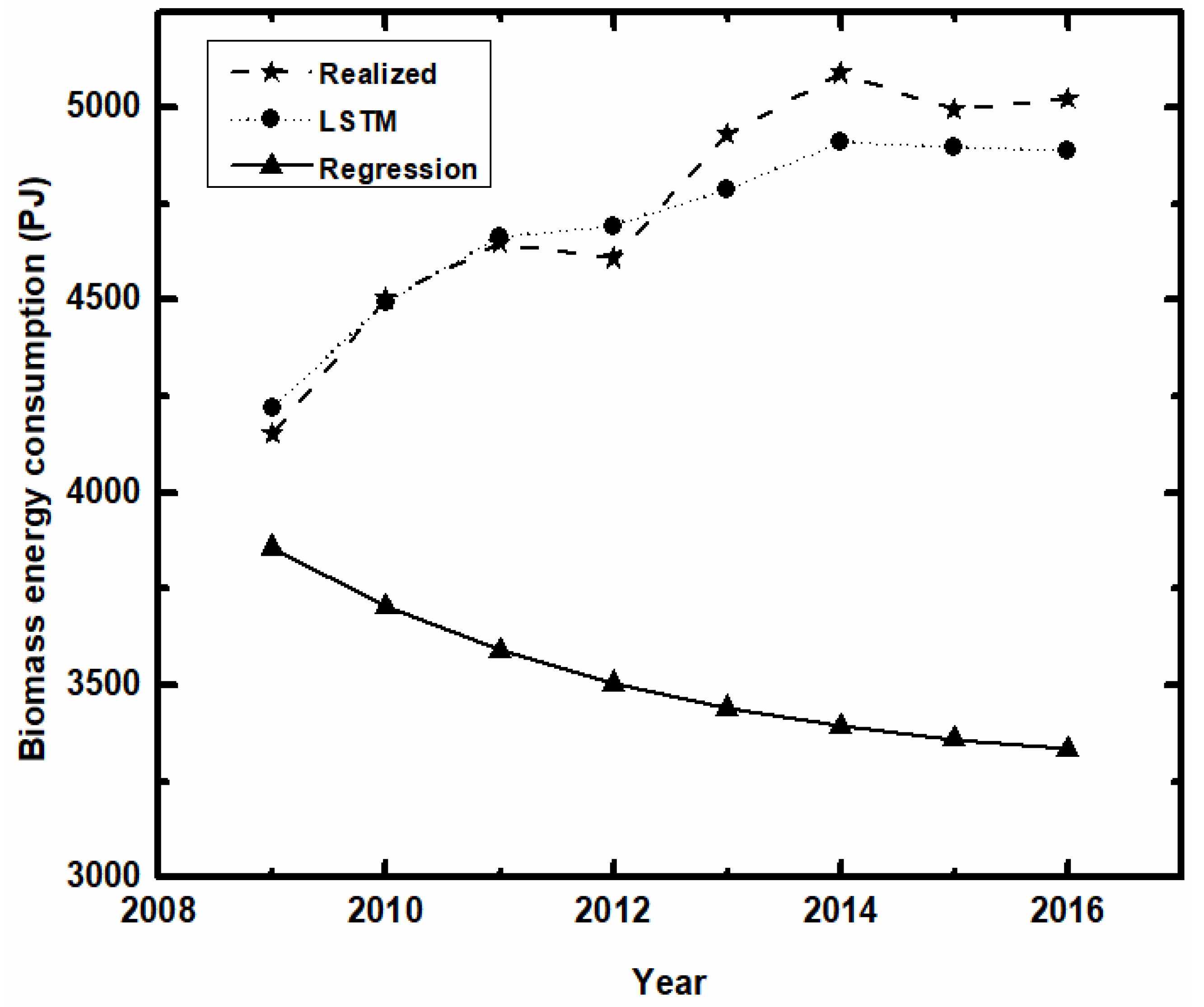

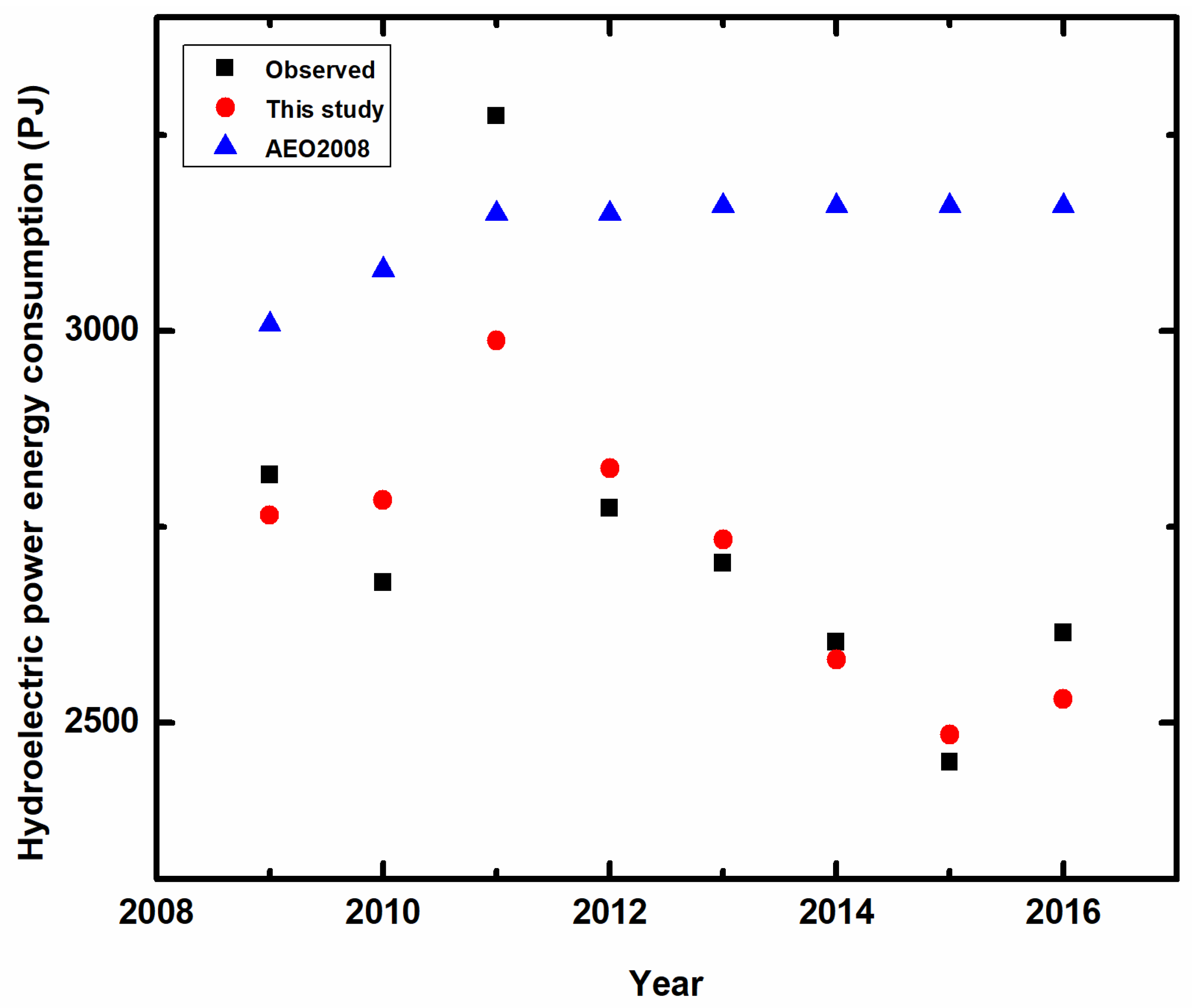

| Forecast Error | Forecast Accuracy | |
|---|---|---|
| LSTM | ||
| Forecast Horizon | ||
| Short-term | 2.39% | 97.61% |
| Medium-term | 3.78% | 96.22% |
| Long-term | 1.40% | 98.60% |
| Overall Indexes | ||
| MAD | 72.16 | 97.36% |
| MAPE | 2.539 | 97.46% |
| RMSE | 96.916 | 96.46% |
| Linear Regression | ||
| Forecast Horizon | ||
| Short-term | 4.38% | 95.62% |
| Medium-term | 9.79% | 90.21% |
| Long-term | 19.15% | 80.85% |
| Overall Indexes | ||
| MAD | 318.293 | 88.38% |
| MAPE | 11.947 | 88.05% |
| RMSE | 358.453 | 86.91% |
| LSTM | Regression | |||
|---|---|---|---|---|
| Forecast Error | Forecast Accuracy | Forecast Error | Forecast Accuracy | |
| Forecast Horizon | ||||
| Short-term | 2.87% | 97.13% | 4.38% | 95.62% |
| Medium-term | 3.90% | 96.10% | 9.79% | 90.21% |
| Long-term | 1.83% | 98.17% | 19.08% | 80.92% |
| Overall Indexes | ||||
| MAD | 83.074 | 96.97% | 317.657 | 88.40% |
| MAPE | 2.865 | 97.13% | 11.918 | 88.08% |
| RMSE | 116.229 | 95.76% | 357.683 | 86.94% |
| LSTM | Regression | |||
|---|---|---|---|---|
| Forecast Error | Forecast Accuracy | Forecast Error | Forecast Accuracy | |
| Forecast Horizon | ||||
| Short-term | 1.76% | 98.24% | 13.14% | 86.86% |
| Medium-term | 2.02% | 97.98% | 26.58% | 73.42% |
| Long-term | 4.03% | 95.97% | 34.12% | 65.88% |
| Overall Indexes | ||||
| MAD | 133.051 | 97.22% | 1272.130 | 73.40% |
| MAPE | 2.708 | 97.29% | 26.047 | 73.95% |
| RMSE | 152.129 | 96.82% | 1358.028 | 71.61% |
| LSTM | Regression | |||
|---|---|---|---|---|
| Forecast Error | Forecast Accuracy | Forecast Error | Forecast Accuracy | |
| Forecast Horizon | ||||
| Short-term | 0.95% | 99.05% | 12.45% | 87.55% |
| Medium-term | 1.68% | 98.32% | 25.65% | 74.35% |
| Long-term | 2.70% | 97.30% | 33.23% | 66.77% |
| Overall Indexes | ||||
| MAD | 91.401 | 98.07% | 1221.053 | 74.26% |
| MAPE | 1.88 | 98.12% | 25.189 | 74.81% |
| RMSE | 107.128 | 97.74% | 1308.052 | 72.43% |
© 2018 by the authors. Licensee MDPI, Basel, Switzerland. This article is an open access article distributed under the terms and conditions of the Creative Commons Attribution (CC BY) license (http://creativecommons.org/licenses/by/4.0/).
Share and Cite
Ma, J.; Oppong, A.; Acheampong, K.N.; Abruquah, L.A. Forecasting Renewable Energy Consumption under Zero Assumptions. Sustainability 2018, 10, 576. https://doi.org/10.3390/su10030576
Ma J, Oppong A, Acheampong KN, Abruquah LA. Forecasting Renewable Energy Consumption under Zero Assumptions. Sustainability. 2018; 10(3):576. https://doi.org/10.3390/su10030576
Chicago/Turabian StyleMa, Jie, Amos Oppong, Kingsley Nketia Acheampong, and Lucille Aba Abruquah. 2018. "Forecasting Renewable Energy Consumption under Zero Assumptions" Sustainability 10, no. 3: 576. https://doi.org/10.3390/su10030576





